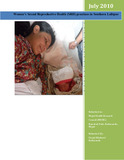Please use this identifier to cite or link to this item:
https://hdl.handle.net/20.500.14356/780Full metadata record
| DC Field | Value | Language |
|---|---|---|
| dc.contributor.author | Khakurel, Deepti | |
| dc.date.accessioned | 2012-12-28T05:40:51Z | |
| dc.date.accessioned | 2022-11-08T10:20:29Z | - |
| dc.date.available | 2012-12-28T05:40:51Z | |
| dc.date.available | 2022-11-08T10:20:29Z | - |
| dc.date.issued | 2010-07 | |
| dc.identifier.uri | http://103.69.126.140:8080/handle/20.500.14356/780 | - |
| dc.description.abstract | This research aims to explore the status of women from Tamang and Pahari communities from Lele and Badikhel V.D.Cs respectively in terms of Sexual Reproductive Health (SRH) issues. This research also aims to identify the needs of women to access SRH rights, list of priority areas and identify issues and practices that cause adverse SRH of women. The research has adopted exploratory, descriptive and explanatory type of research design. In Nepal, the status of women is restricted to the lower strata as compared to men both economically and socially. This situation has led to adverse impacts upon the sexual and reproductive health, hence, retarding the overall development in Nepal. Women, in both the patriarchal and matriarchal communities have been discriminated. They have been just a shadow in all the relevant arenas such as education, health, employment and other civic engagements. Women’s health and particularly their sexual and reproductive health is severely affected by their low familial and social status, patriarchal perspectives, traditional values, illiteracy, poverty, etc. Women have limited access to information and health services and awareness level. The total population of the country which is almost equal proportion shows low life expectancy for female than male. The country has also very high maternal mortality rate and 90 percent of the maternal deaths happen in the rural areas. With only 10.2 percent of the rural women giving birth being attended by a skilled birth attended, most women fall prey to causes of maternal death like hemorrhage, obstructed labor, abortion, ectopic pregnancy or obstetric complications which are preventable. Lele and Badikhel V.D.C of the Lalitpur district have total population of 15000 and 3212 respectively with both the villages having almost even proportion of male and female. Both the villages are in close radius to the capital city center. Women from the Tamang community in Lele district have not been able to progress from highly conservative traditional practices. The education qualities of the women are in dire condition as many are unable to write their names and lack awareness to educate their children. The women are unaware about their SRH rights and are very reluctant to take health services provided in the area. The lack of awareness and low economic status among the Tamang has resulted in early marriage and early motherhood, no antenatal care and sexual and reproductive health. | en_US |
| dc.language.iso | en_US | en_US |
| dc.subject | Sexual Reproductive Health | en_US |
| dc.title | Women’s Sexual Reporductive Health(SRH) practices in Southern Lalitpur | en_US |
| dc.type | Technical Report | en_US |
| Appears in Collections: | Post Graduate Grant (PG) Reports | |
Items in DSpace are protected by copyright, with all rights reserved, unless otherwise indicated.

